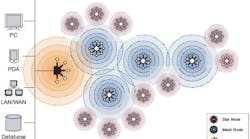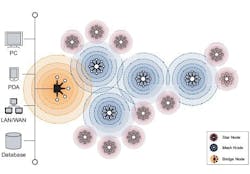Experts disagree about wireless sensor systems
The experts we interviewed for our November, 2006 feature about online condition monitoring were quite calm and consistent until we started discussing the situation with wireless sensor systems. There, they break down into three camps:
- Wireless sensors and data transfer systems are ready to revolutionize the cost-benefit equation for continuous monitoring – come and get them.
- Wireless is a cost-effective alternative to wired networks for transmitting data or information, but wireless sensors are not yet ready for industrial applications – check back in a year or three.
- Wireless is getting a lot of attention but due to serious battery life, radio frequency and data transmission load limitations, wireless sensors will remain suitable only for low-demand applications.
Why don’t all these smart people agree? One reason is because they have different criteria for what it takes to perform effective online condition monitoring. But, they also have very different assessments of the current state of the technology.
The vision: A world unbound by wires
In a recent presentation on the future of predictive maintenance, Elsa Anzalone, account manager, Azima (www.azimainc.com) and Jack Nicholas, Jr., P.E., CMRP, senior technical advisor, Allied Reliability (www.alliedreliability.com) say wireless transmitters show promise of greatly reducing (by up to two-thirds) the cost to install and maintain predictive, condition monitoring systems. “To date, wireless sensors have been developed for vibration, speed, temperature, pressure, current, partial discharge activity and certain other key parameters,” say Nicholas and Anzalone. “Locally powered videocameras with wireless transmission capability may also be installed at remote stations for observation of critical gauges or areas of a facility.”
The majority opinion: Utopia is a ways off
Wireless sensors are available, “But today, there are serious limitations,” says Jack Dischner, president, Commtest (www.commtest.com). “They give you data when they’re programmed to wake up, not whenever you need it. Some have clipped frequency response, and some systems require repeaters sprinkled throughout the plant. The FCC limit of 0.3 Watts can mean slow data transmission.”
While acknowledging that wireless can have a “dramatic effect” on bringing online systems to more “less critical” assets, “The current state-of-the-art for wireless sensors is perhaps not as close to utopia as some would have us believe,” says Steve Sabin, editor of GE's ORBIT magazine. Consider the following challenges that a wireless sensor supplier must address:
Data timing: Sensors are configured to collect and transmit data on a schedule, not based on what the machine is doing. Though this saves battery life, it creates a significant technical limitation of the devices themselves for applications involving variable-speed or variable-load machines. In these applications, the benefit of an online system is that it checks the machine state before testing to ensure repeatable test conditions for
trending, as well as identifying whether the operating state itself has changed. Without repeatable test conditions, monitoring is not always very useful.
Power: Transmitting the signal is only half the purpose of wires in a conventional sensor system. The other purpose is to supply power. Battery-powered sensors are an option, but if the number of battery-powered sensors in a plant proliferate, it isn’t hard to foresee thousands of batteries. Even with a long battery life of several years, that still amounts to thousands of batteries to change (and dispose of) each year. This takes the designer down even more challenging avenues such as self-powered technologies (solar, etc.).
Transmission integrity: Industrial plants are extremely noisy environments as far as the electromagnetic spectrum is concerned. Rarely is there a clear line-of-sight between sensors and the location of the host system (which might be in a control room). The reliability of transmission in such an environment creates very difficult challenges, particularly when it has to be balanced with cost-per-point, power consumption and other issues.
Licensing: Because wireless sensors use radio signals, there is the issue of licensing in multiple countries. There is no universal standard for radio frequency usage or licensing.
Transmission range. Peer-to-peer approaches can be used as part of a mesh architecture, where each device is capable of sending and receiving from every other device. Hence, each device doesn’t need a range of thousands of feet, it only needs to be able to communicate with its nearest neighbor, which will in turn relay the message to its nearest neighbor, etc. However, this requires sensors to be turned on more frequently, thus requiring more power.
Cost per point. Sensor costs are high and the user is limited to choosing
the sensor that has a transmitter, not necessarily the best sensor for his application. Embedding lots of signal processing and memory in each sensor raises the cost per point, but means the sensor can store information if communications are temporarily interrupted.
“Will we ever have a sensor that combines low total installed cost, small size, excellent transmission integrity, long battery life or battery-free operation, universal compliance with the RF licensing authorities globally -- in essence, all the benefits of hardwired sensors without the wires? It’s hard to say,” says Sabin. “What we can say with assurance is that it isn’t here today, and it isn’t likely to appear anytime soon.
“Are many people working on this? Yes, including ourselves. Is progress being made? Yes. Will we see wireless sensors in greater use in the not-to-distant future? Yes. Will these sensors possess all the ideal characteristics described above? No, we don’t think so. Like all technologies, we’ll see such sensors deployed where the benefits outweigh the costs, and there will be places where the cost of running wires eclipses the inconvenience of changing batteries, periodic signal interruption, the possible need for repeater antennas, etc.
“For this reason, we aren’t yet seeing wireless sensors that completely eliminate the need for wires everywhere in the system. Instead, we are seeing architectures that selectively employ wireless in certain parts of the system. In our case, that typically means wires between the sensors and some type of data concentrator or storage device, and then wireless from the storage device back to a host computer that acts as the HMI of the system. Most often, wireless Ethernet is used for this.
“By strategically placing data concentrators in the plant, a balance can be struck between the cost of wiring and the cost of data concentrators. And, because multiple points feed into a single data concentrator, you can fit each data concentrator with things like higher-powered antennas to increase transmission distances. So in essence, wireless does have a role in eliminating part of the wires in a system, but not all of the wires. At least not yet.”
Specialists say it’s here now
On the other hand, our wireless-centric vendor asserts that all these issues have been overcome, at least well enough for the less-critical assets where the lower installed cost of wireless systems can make the difference between doing or not doing online monitoring.
“There are cases where wired systems cost 10 times as much as wireless,”says Gary Ambrosino, CEO, Sensicast (www.sensicast.com) “For example, an ethanol plant would take 100 miles of wire at a cost of $1 million. Wireless eliminates that cost.
“If a system costs $10,000 instead of $100,000, does that change the situation? At $10,000, the ROI lets you do it.”
On wireless sensors, battery life depends on how often you collect data. The trick is to not have the radio and transmitter on except when you need them. “Collecting every 15 to 30 seconds, the batteries will last two to three years,” says Ambrosino. “Collecting every five minutes, it’s three to five years. Most of our customers accept changing batteries every two to three years.”
At “slightly higher expense,” he says, “We can use harvested energy – heat, vibration or non-contact coupling with a power cable. A fuel cell and battery combination can last 20 years.”
Last words
“Wireless can ease and reduce the cost of installation,” says Ed Bondoc, product manager, surveillance systems, SKF Reliability Systems (www.skf.com). “It’s useful where wire can’t be used or is prohibitively expensive -- in some applications, half or more of the cost can be cabling. There, wireless can be an enabling technology. But standards, batteries, etc. are still evolving.”
“Wireless systems assume there will be multiple sensors per machine and multiple machines to be monitored within a relatively small area,” says Alan Friedman, senior engineer, DLI Engineering Corporation (www.dliengineering.com).
“In this case, it makes sense to use off-the-shelf, inexpensive sensors (including non-vibration related sensors) that are right for the application, and cable them short distances to a processor located on or near the machines of interest. The processor then sends diagnostic results and/or data wirelessly (802.11 WiFi) or via Ethernet to a central server or to individual workstations. Multiple processors are installed plant-wide, close to the machines they are monitoring, then integrated on a higher level at a server or control center.”
“Wireless technology continues to hold a lot of promise,” says Tom Alford, product marketing manager, condition monitoring hardware, Rockwell Automation (www.ra.rockwell.com). “Today, it is mostly used to serve specific applications and not widespread monitoring throughout the plant. Work is being done today relative to energy management and protocols that will make this technology.”
“Wireless is extending condition monitoring to applications where it wasn’t practical in the past, for example, 25-100 hp pumps,” says Kevin Fitzgerald, senior program director, new ventures group, Invensys (www.invensys.com). “They may not shut the plant down, but problems with them can upset the process.”
“The foreseeable future will see the coexistence of wired and wireless systems for less critical assets,” says Sabin. “Very simply, in our estimation, wireless will augment – not replace – the use of wired systems, until and unless all the technical challenges inherent in wireless can be overcome.”
“True wireless is not there yet, but I think over the next year we’ll see a reinvention of the technology,” says Dischner.

